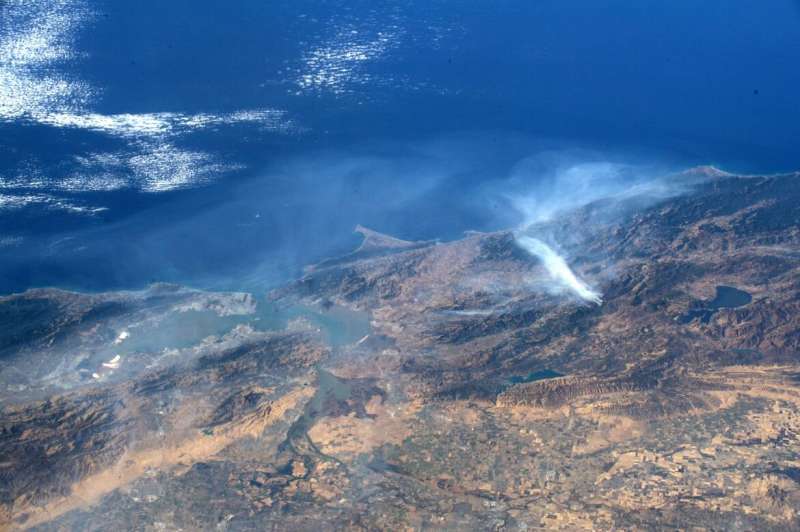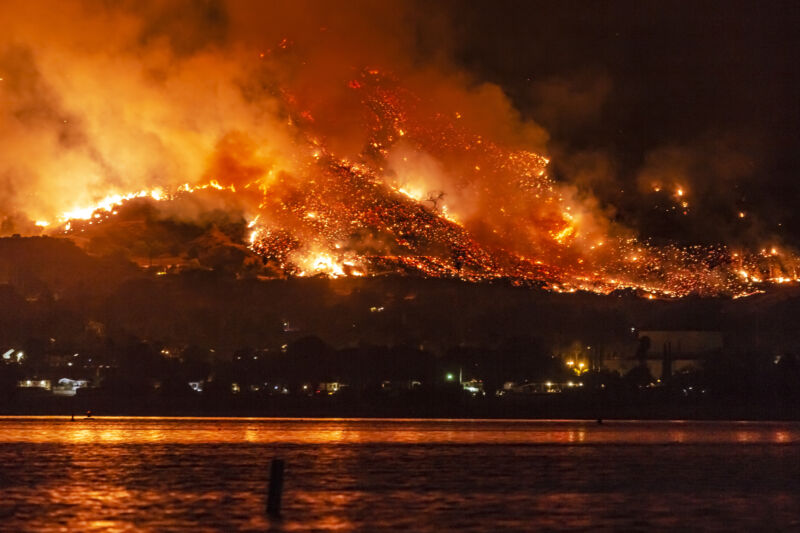Study: Increasingly frequent wildfires linked to human-caused climate change

Research by scientists from UCLA and Lawrence Livermore National Laboratory strengthens the case that climate change has been the main cause of the growing amount of land in the western U.S. that has been destroyed by large wildfires over the past two decades.
Rong Fu, a UCLA professor of atmospheric and oceanic sciences and the study's corresponding author, said the trend is likely to worsen in the years ahead. "I am afraid that the record fire seasons in recent years are only the beginning of what will come, due to climate change, and our society is not prepared for the rapid increase of weather contributing to wildfires in the American West."
The dramatic increase in destruction caused by wildfires is borne out by U.S. Geological Survey data. In the 17 years from 1984 to 2000, the average burned area in 11 western states was 1.69 million acres per year. For the next 17 years, through 2018, the average burned area was approximately 3.35 million acres per year. And in 2020, according to a National Interagency Coordination Center report, the amount of land burned by wildfires in the West reached 8.8 million acres—an area larger than the state of Maryland.
But the factors that have caused that massive increase have been the subject of debate: How much of the trend was caused by human-induced climate change and how much could be explained by changing weather patterns, natural climate variation, forest management, earlier springtime snowmelt and reduced summer rain?
For the study, published in the Nov. 9 edition of the journal Proceedings of the National Academy of Sciences, the researchers applied artificial intelligence to climate and fire data in order to estimate the roles that climate change and other factors play in determining the key climate variable tied to wildfire risk: vapor pressure deficit.
Vapor pressure deficit measures the amount of moisture the air can hold when it is saturated minus the amount of moisture in the air. When vapor pressure deficit, or VPD, is higher, the air can draw more moisture from soil and plants. Large wildfire-burned areas, especially those not located near urban areas, tend to have high vapor pressure deficits, conditions that are associated with warm, dry air.
The study found that the 68 percent of the increase in vapor pressure deficit across the western U.S. between 1979 and 2020 was likely due to human-caused global warming. The remaining 32 percent change, the authors concluded, was likely caused by naturally occurring changes in weather patterns.
The findings suggest that human-induced climate change is the main cause for increasing fire weather in the western United States.
"And our estimates of the human-induced influence on the increase in fire weather risk are likely to be conservative," said Fu, director of UCLA's Joint Institute for Regional Earth System Science and Engineering, a collaboration with NASA's Jet Propulsion Laboratory.
The researchers analyzed the so-called August Complex wildfire of 2020, which burned more than a million acres in Northern California. They concluded that human-induced warming likely explains 50 percent of the unprecedentedly high VPD in the region during the month the fire began.
Fu said she expects wildfires to continue to become more intense and more frequent in the western states overall, even though wetter and cooler conditions could offer brief respites. And areas where vast swaths of plant life have already been lost to fires, drought, heatwaves and the building of roads likely would not see increases in wildfires despite the increase of the vapor pressure deficit.
"Our results suggest that the western United States appears to have passed a critical threshold—that human-induced warming is now more responsible for the increase of vapor pressure deficit than natural variations in atmospheric circulation," Fu said. "Our analysis shows this change has occurred since the beginning of the 21st century, much earlier than we anticipated.Dryer, warmer night air is making some Western wildfires more active at night
More information: Yizhou Zhuang et al, Quantifying contributions of natural variability and anthropogenic forcings on increased fire weather risk over the western United States, Proceedings of the National Academy of Sciences (2021). DOI: 10.1073/pnas.2111875118
Journal information: Proceedings of the National Academy of Sciences
Provided by University of California, Los Angeles
The blame game: How much are we responsible for recent wildfires?
DOUG JOHNSON - 11/5/2021

This summer, the Western United States saw a truly devastating wildfire season. Across the country, more than 48,000 wildfires raged, damaging more than six million hectares of land. It would be nice to think that humans weren’t the primary cause of these events and that natural changes in weather patterns contributed to how dry and fire-prone parts of the world have become.
But the reality isn't so nice. Climate change is likely the cause of the wildfires, according to new research that aimed to quantify just how much blame we can lay at the feet of natural causes when it comes to the increasing rates of wildfires in the US’s West. “We want to know how much this increase in fire weather is just changing weather patterns and how much cannot be explained by changing weather patterns,” Rong Fu, one of the paper’s authors and a professor at UCLA’s Department of Atmospheric and Oceanic Sciences, told Ars.
The research began around a year ago. Fu and some of her colleagues live in California and were all impacted by the wildfires, so they wanted to investigate what is causing them.
How bad is it?
Fu and her team deployed a technique called an "ensemble constructed flow analogue." In short, they looked back in time between 1979 and 2010 in the region and found cases in which the naturally occurring weather looked much as it does now. From there, they looked at a figure called the vapor pressure deficit (VPD)—basically, how dry and “thirsty” the area is—both in the historic and modern cases.Advertisement
VPD is the leading cause of forest fires on the US West Coast and many other places around the world. So if the modern VPD is higher than it was in historic cases with similar weather patterns, it would suggest that there is a non-natural component to how fire-prone things are currently. “Basically, the difference between [the present VPD] and the [VPD] we can get from the same weather patterns in the past is due to climate change,” she said.
Fu noted that these cases won’t have the same weather patterns, however. She also added that the work took into consideration various other factors that might have played a role, such as changes in vegetation.
In all, the research suggests that only around 32 percent of VPD trends can be attributed to natural causes. The remaining 68 percent or so cannot—and it’s likely that climate change is the culprit.
Ruh-roh
As a result, their estimates of climate change impacts is not as large as it would be in reality; it’s on the more conservative side of things. “We want to be as conservative as possible. That way, when we say, 'Climate change contributes two-thirds of [the increase to] fire weather,' we know that’s likely to be true and only an underestimate of climate change,” she said.
Trying to suss out exactly how much human activity impacts climate change is a tricky business because the climate changes to some degree on its own. But this research is another step toward understanding just how much humans are responsible. Further, according to Fu, the methods used in this paper could be deployed elsewhere around the world. “I think this approach can be generalized to other areas,” she said.
PNAS, 2021. DOI: 10.1073/pnas.2111875118 (About DOIs)
No comments:
Post a Comment